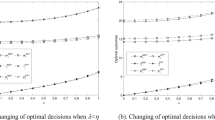Abstract
Due to the growth of community awareness, the popularity of green products has increased. In addition, with increasing Internet usage, companies use the Internet as a direct channel along with the traditional way to sell and distribute their products through retailers. This paper investigates pricing in a supply chain consisting of a manufacturer and a retailer with two distribution channels, direct (Internet) and indirect (retailer). The decision variables of the manufacturer are wholesale price and greening level of the product, while the retail price is the decision variable of the retailer. Due to the existence of uncertain conditions in the real world, this problem has been modeled by fuzzy parameters. A game theory approach is employed to provide equilibrium solutions for cooperative and non-cooperative scenarios. Finally, a numerical analysis is presented, and a sensitivity analysis is investigated. For example, it is concluded that vertical cooperation in the supply chain, in addition to increasing the entire supply chain profit, increases the product greenness level and thus improves the environment.







Similar content being viewed by others
References
Yang MGM, Hong P, Modi SB (2011) Impact of lean manufacturing and environmental management on business performance: an empirical study of manufacturing firms. Int J Prod Econ 129(2):251–261
Diabat A, Kannan D, Mathiyazhagan K (2014) Analysis of enablers for implementation of sustainable supply chain management: a textile case. J Clean Prod 83:391–403
de Sousa Jabbour ABL, Jabbour CJC, Govindan K, Kannan D, Salgado MH, Zanon CJ (2013) Factors affecting the adoption of green supply chain management practices in Brazil: empirical evidence. Int J Environ Stud 70(2):302–315
Karakayali I, Emir-Farinas H, Akcali E (2007) An analysis of decentralized collection and processing of end-of-life products. J Oper Manag 25(6):1161–1183
Lin Y-H, Tseng M-L (2016) Assessing the competitive priorities within sustainable supply chain management under uncertainty. J Clean Prod 112:2133–2144
Zhu Q, Sarkis J, Lai K-h (2007) Initiatives and outcomes of green supply chain management implementation by Chinese manufacturers. J Environ Manage 85(1):179–189
Li B, Zhu M, Jiang Y, Li Z (2016) Pricing policies of a competitive dual-channel green supply chain. J Clean Prod 112:2029–2042
Palevich R (2011) The lean sustainable supply chain: how to create a green infrastructure with lean technologies. Ft Press, New York
Seuring S (2013) A review of modeling approaches for sustainable supply chain management. Decis Support Syst 54(4):1513–1520
Ghosh D, Shah J (2012) A comparative analysis of greening policies across supply chain structures. Int J Prod Econ 135(2):568–583
Tsay AA, Agrawal N (2004) Channel conflict and coordination in the e-commerce age. Prod Oper Manag 13(1):93–110
Xu H, Liu ZZ, Zhang SH (2012) A strategic analysis of dual-channel supply chain design with price and delivery lead time considerations. Int J Prod Econ 139(2):654–663
Huang S, Yang C, Liu H (2013) Pricing and production decisions in a dual-channel supply chain when production costs are disrupted. Econ Model 30:521–538
Chen J, Zhang H, Sun Y (2012) Implementing coordination contracts in a manufacturer Stackelberg dual-channel supply chain. Omega 40(5):571–583
Webster S, Weng ZK (2008) Ordering and pricing policies in a manufacturing and distribution supply chain for fashion products. Int J Prod Econ 114(2):476–486
Lee CH (2007) Coordination on stocking and progressive pricing policies for a supply chain. Int J Prod Econ 106(1):307–319
Xie Y, Petrovic D, Burnham K (2006) A heuristic procedure for the two-level control of serial supply chains under fuzzy customer demand. Int J Prod Econ 102(1):37–50
Handfield R, Warsing D, Wu X (2009) (Q, r) Inventory policies in a fuzzy uncertain supply chain environment. Eur J Oper Res 197(2):609–619
Rommelfanger H (2004) The advantages of fuzzy optimization models in practical use. Fuzzy Optim Decis Mak 3(4):295–309
Zimmermann H-J (2000) An application-oriented view of modeling uncertainty. Eur J Oper Res 122(2):190–198
Wei J, Zhao J (2011) Pricing decisions with retail competition in a fuzzy closed-loop supply chain. Expert Syst Appl 38(9):11209–11216
Zadeh LA (1965) Fuzzy sets. Inf Control 8(3):338–353
Zhao J, Wei J, Sun X (2017) Coordination of fuzzy closed-loop supply chain with price dependent demand under symmetric and asymmetric information conditions. Ann Oper Res 257(1–2):469–489
Özceylan E, Kabak M, Dağdeviren M (2016) A fuzzy-based decision making procedure for machine selection problem. J Intell Fuzzy Syst 30(3):1841–1856
Zhao R, Tang W, Yun H (2006) Random fuzzy renewal process. Eur J Oper Res 169(1):189–201
Nahmias S (1978) Fuzzy variables Fuzzy sets and systems 1(2):97–110
Swami S, Shah J (2011) Channel coordination in green supply chain management: the case of package size and shelf-space allocation. Technol Oper Manag 2(1):50–59
Sheu J-B (2011) Bargaining framework for competitive green supply chains under governmental financial intervention. Transp Res Part E Logist Transp Rev 47(5):573–592
Sheu J-B, Chen YJ (2012) Impact of government financial intervention on competition among green supply chains. Int J Prod Econ 138(1):201–213
Barari S, Agarwal G, Zhang WC, Mahanty B, Tiwari M (2012) A decision framework for the analysis of green supply chain contracts: an evolutionary game approach. Expert Syst Appl 39(3):2965–2976
Cao J, Zhang X (2013) Coordination strategy of green supply chain under the free market mechanism. Energy Procedia 36:1130–1137
Zhang C-T, Liu L-P (2013) Research on coordination mechanism in three-level green supply chain under non-cooperative game. Appl Math Model 37(5):3369–3379
Zhang C-T, Wang H-X, Ren M-L (2014) Research on pricing and coordination strategy of green supply chain under hybrid production mode. Comput Ind Eng 72:24–31
Huang Y, Wang K, Zhang T, Pang C (2016) Green supply chain coordination with greenhouse gases emissions management: a game-theoretic approach. J Clean Prod 112:2004–2014
Zhang Q, Tang W, Zhang J (2016) Green supply chain performance with cost learning and operational inefficiency effects. J Clean Prod 112:3267–3284
Aydin R, Kwong C, Ji P (2016) Coordination of the closed-loop supply chain for product line design with consideration of remanufactured products. J Clean Prod 114:286–298
Li S, Ahn CK, Xiang Z (2018) Sampled-data adaptive output feedback fuzzy stabilization for switched nonlinear systems with asynchronous switching. IEEE Trans Fuzzy Syst 27(1):200–205
Li S, Ahn CK, Xiang Z (2019) Adaptive fuzzy control of switched nonlinear time-varying delay systems with prescribed performance and unmodeled dynamics. Fuzzy Sets Syst 371:40–60
Xu R, Zhai X (2010) Analysis of supply chain coordination under fuzzy demand in a two-stage supply chain. Appl Math Model 34(1):129–139
Bilgen B (2010) Application of fuzzy mathematical programming approach to the production allocation and distribution supply chain network problem. Expert Syst Appl 37(6):4488–4495
Pourjavad E, Mayorga RV (2019) Multi-objective fuzzy programming of closed-loop supply chain considering sustainable measures. Int J Fuzzy Syst 21(2):655–673
Wang W, Cui Y, Peng T, Wang W (2007) Noncooperative power control game with exponential pricing for cognitive radio network. In: 2007 IEEE 65th vehicular technology conference-VTC2007-Spring, IEEE, pp 3125–3129
Chapman AC, Mhanna S, Verbic G (2017) Cooperative game theory for non-linear pricing of load-side distribution network support. In: The 3rd IJCAI Algorithmic Game Theory Workshop
Clempner JB (2019) Optimal level of transfer pricing for profit sharing: a Lagrange regularized game theory approach. Optim Eng 20(3):833–852
Hobbs BF, Kelly KA (1992) Using game theory to analyze electric transmission pricing policies in the United States. Eur J Oper Res 56(2):154–171
Zhao J, Tang W, Zhao R, Wei J (2012) Pricing decisions for substitutable products with a common retailer in fuzzy environments. Eur J Oper Res 216(2):409–419
Yang D, Xiao T (2017) Pricing and green level decisions of a green supply chain with governmental interventions under fuzzy uncertainties. J Clean Prod 149:1174–1187
Zhao J, Sun N (2020) Government subsidies-based profits distribution pattern analysis in closed-loop supply chain using game theory. Neural Comput Appl 32(6):1715–1724
Taleizadeh AA, Mamaghan MK, Torabi SA (2018) A possibilistic closed-loop supply chain: pricing, advertising and remanufacturing optimization. Neural Comput Appl 32(4):1195–1215
Zhu W, He Y (2017) Green product design in supply chains under competition. Eur J Oper Res 258(1):165–180
Basiri Z, Heydari J (2017) A mathematical model for green supply chain coordination with substitutable products. J Clean Prod 145:232–249
Jamali M-B, Rasti-Barzoki M (2018) A game theoretic approach for green and non-green product pricing in chain-to-chain competitive sustainable and regular dual-channel supply chains. J Clean Prod 170:1029–1043. https://doi.org/10.1016/j.jclepro.2017.09.181
Khosroshahi H, Rasti-Barzoki M, Hejazi SR (2019) A game theoretic approach for pricing decisions considering CSR and a new consumer satisfaction index using transparency-dependent demand in sustainable supply chains. J Clean Prod 208:1065–1080
Zhong Q, Wang Z, Hong X (2018) Pricing decisions in a fuzzy supply chain system considering different duopolistic retailers’ competitive behavior. Int J Fuzzy Syst 20(5):1592–1605
Jamali M-B, Rasti-Barzoki M (2019) A game theoretic approach to investigate the effects of third-party logistics in a sustainable supply chain by reducing delivery time and carbon emissions. J Clean Prod 235:636–652
Liu Y-K, Liu B (2003) Expected value operator of random fuzzy variable and random fuzzy expected value models. Int J Uncertain Fuzziness Knowl Based Syst 11(02):195–215
Author information
Authors and Affiliations
Corresponding author
Ethics declarations
Conflict of interest
The authors declared that they have no conflicts of interest to this work.
Additional information
Publisher's Note
Springer Nature remains neutral with regard to jurisdictional claims in published maps and institutional affiliations.
Rights and permissions
About this article
Cite this article
Jamali, MB., Gorji, MA. & Iranpoor, M. Pricing policy on a dual competitive channel for a green product under fuzzy conditions. Neural Comput & Applic 33, 11189–11201 (2021). https://doi.org/10.1007/s00521-020-05567-2
Received:
Accepted:
Published:
Issue Date:
DOI: https://doi.org/10.1007/s00521-020-05567-2




